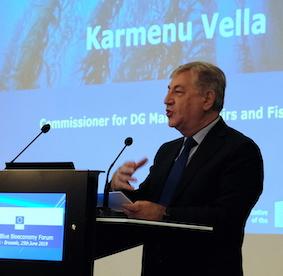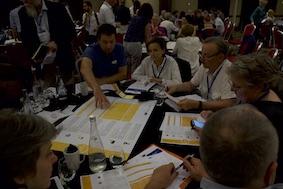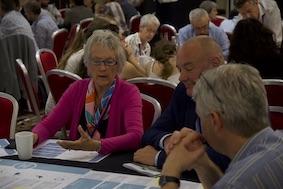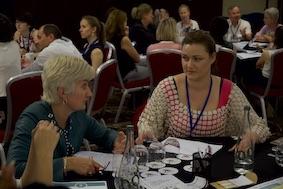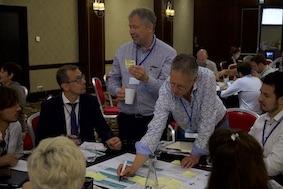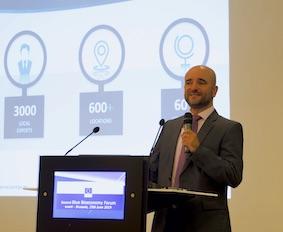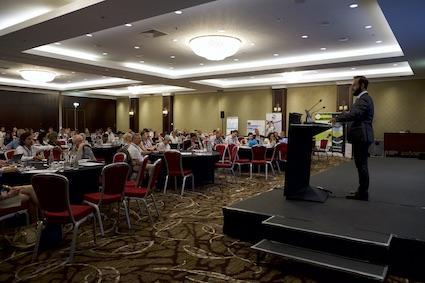Channelling the blockbuster film Aladdin, European Commissioner for Environment, Maritime Affairs and Fisheries Karmenu Vella called on delegates at the second Blue Bioeconomy Forum (BBF) Conference in Brussels to put collaboration, transparency and sustainability at the heart of efforts to develop this sector in a responsible way as a “force for good”. But a more pressing challenge for the BBF delegates was to provide essential feedback on the draft Roadmap for the Blue Bioeconomy ahead of its launch after the summer. No pressure then!
The blue bioeconomy is a genie in the bottle because it still manages to fit into a relative small place, the Commissioner suggested, but if the conditions are right it can break free and deliver “blue-tinted magic” everywhere. The EU’s updated Bioeconomy Strategy was developed to do just that. The story of Aladdin teaches us that actions have consequences, so we have to get it right from the start, and the huge problem of plastics in the ocean is a cautionary tale to avoid past mistakes, he stressed. Just because a plastic is ‘bio’ does not guarantee that it breaks down faster in the ocean, and the old adage that there are “always plenty of fish in the sea is no longer the case in some regions”.
This means we have a legal obligation to make fisheries sustainable, and we can do more to make use of all fish resources, he added. The move towards non-waste models for all primary producers, including fishing and aquafarming, is the logical next step. He offered several examples including clusters working towards industrial symbiosis in Sweden, saving on costs, transforming waste, mitigating eutrophication, cutting back on CO2 emissions (up to 60,000 tonnes a year!), promoting renewable energy and creating new jobs along the way. It is a good example of “local empowerment towards transformation”.
For all of these reasons, the Commissioner intoned the need for enhanced collaboration, transparent actions, and sustainable thinking across the board. The Bioeconomy Strategy aims to promote bioeconomic development within the planet’s ecological boundaries. The EU’s new Blue Investment Platform is an important tool for transparency, and he stressed that the Commission will listen to what stakeholders have to say and help producers and consumer assess their environmental sustainability. “To be successful in the long run, sustainability must be at the heart of the blue bioeconomy,” he said. That means protecting the environment, enhancing biodiversity, and reducing pressure on natural resources.
The land-sea connection
Sieglinde Gruber, Head of Unit Healthy Oceans & Seas, DG Research and Innovation, said that sustainability is also at the heart of the Forum’s talks, because young people demonstrating for the environment around Europe “expect us to act now”.
The Bioeconomy Strategy’s seven major policies and 14 concrete actions now have visible land-sea connections and important marine components. The three pillars of the Strategy, she explained, are to unlock the bioeconomy, stimulate employment across Europe (supported by vital local, national and regional contributions), and to further understand the ecological boundaries of the sector.
x
Examples of actions mentioned included the BlueMed pilot action on a healthy plastic-free Mediterranean Sea, which she urged BBF delegates to follow up on at the event, and a €30 million ERA-NET scheme co-funded by the Commission and Member States, called BlueBio, aimed at developing innovative uses of underutilised fisheries and aquaculture resources, to unlock the waste, biomass and digitalisation. The high potential of algae-based research projects was mentioned, as too the Bio-based Industries Joint Undertaking (BBI-JU). Mrs Gruber acknowledged the special nature of this subject in research terms and called on BBF delegates to “connect the dots” so policymakers can “harvest the discussions” to ensure a sustainable European bioeconomy overall.
The presence of Julien Guerrier, Director of EASME, which is the European Commission Agency supporting small and medium-sized enterprises, was a sign of the importance of this business sector in the emerging blue bioeconomy. In what he called a very “dynamic sector valued at more than €4 billion, depending on the definition”, EASME plays a key role bridging the gap and bringing to market the results of targeted research through the EU programmes it manages. There is a wealth of Blue bioeconomy projects funded by all EU programmes. The European Maritime and Fisheries Fund (EMFF) is a key provider with projects such as AMALIA which will produce an edible film for seafood products to reduce plastics and increase shelf life of products in our supermarkets. He mentioned also several examples such as Saltgae under Horizon 2020, which is proving the viability and sustainability of using algae to treat saline wastewater. He underlined the role of COSME – Europe’s programme for small and medium-size enterprises – and the Enterprise Europe Network in helping companies innovate and grow in the blue bioeconomy. Under this programme, he gave the example of FishskinLab, which is creating fish leather products like handbags for the fashion industry. The European Innovation Council Pilot and Horizon 2020 also both support and boost innovation and growth in the sector, with projects like SMILE, which is using microalgae to develop naturally active ingredients for weight loss and brain health, and InnovaFeed’s insect-based feed in aquaculture.
x
Coffee, cafés and more …
At BBF Conference, the coffee breaks also served as excellent networking opportunities alongside parallel one-to-one meeting spaces. Another feature of the event was the World Café which is a format well suited to discussing and deliberating on multiple subjects at the same time – in this case the main “ways forward” presented in draft form from the Roadmap for the Blue Bioeconomy. See our dedicated article on the ways forward here.
BBF News joined the gatherings and came across some fascinating projects exhibiting alongside the 10 World Café ‘table-topics’ set up in main ballroom of Brussel’s Marriott Hotel Grand Place. We met Linda Scholten of the European Federation of Food Science and Technology who was representing AQUABIOPRO-FIT.
“We find new ways to use European aquaculture and fishery waste, but you can’t really call it that because it’s still meant for human consumption like supplements for fitness and health,” she said, explaining that even ‘by-products’ and ‘side products’, the current go-to words, are not quite fit for purpose. “If you’ve got a better alternative word, let me know!” she challenged BBF News. “That’s one of the reasons we are here, to deal with the consumer acceptance aspects.”
Gordon Dalton of University College Cork and representing the MUSICA project which is preparing to further develop its ‘Blue Growth 5’ multi-use demonstrator – a floating marine micro-platform tailored to the small island market, providing fresh-desalinated water (1000 m3), electricity (860 kw/h) and support services for local offshore aquaculture. For example, the pilot platform will sit 2 km off the Greek island of Innouses (Aegean, population 800) using wind, solar and wave power to supply all of the island’s needs.
Ferraro Angelo of ValueMag had all kinds of samples of his project’s colourants, additives and some cool tailor-made tools that they use to produce products from algae using new magnetic cultivation and extraction techniques. “There could be millions of microalgae out there, but only 12 are already approved for cosmetics and three for food,” he told BBF News. “This is why we see cosmetics as the most likely and fastest path to market right now. If nothing changes or improves, we’ll have to focus on those and manipulate them to be profitable, but my ideal would be to have simpler and faster regulatory instruments (one-stop-shops) for approving strains”.
The European Algae Biomass Association is trying to get the players together to spread the cost of approval (which can run up to €100,000 per application), to open the market for a few more species in the short term, he noted.
Inspirational approaches
The afternoon sessions introduced delegates to several inspirational projects and approaches as well as a wide-reaching discussion on European support for innovation. Makis Tifkesis informed the audience about the European Enterprise Network’s 3000 local experts (FTEs), 600+ locations and 60+ countries worldwide handling total funding of €180 million, and how it supports blue bioeconomy endeavours. Haik van Exel of Hortimare presented the challenges faced in the seaweed industry, how it complements agriculture, and the issues with quality standards in this diverse and fast-moving sector where knowledge is still limited and there is a lack clarity on geographical limits.
x
Patricia Harvey of D-FACTORY spoke about the project’s successful biorefinery technologies, the importance of having an investor in the consortium, and the challenges they faced mostly with seasonality, controlling pests, and other ‘farming-related’ concerns. “It’s a new area so we had to solve issues as we went along,” she said, showing examples of different quality and forms of biomass (also farming issues), and the problem of harvesting 10 micron-sized cells out of water when they have no cell-wall to protect them.
x
In the next video, watch Patricia Harvey explain why she thinks the Blue Bioeconomy Forum and the upcoming roadmap will be important for Europe, and how she benefited fromt the exchanges of the day.
x
Kate Dempsey of the Irish Mussel Seed Company and Pedro Lima of Sea4us, a biopharmaceutical company, also shared their stories and the challenges faced in starting and growing their businesses, including the difficulty with licensing (ten years in the case of mussel seed farming in Ireland). Watch the video to hear her message.
x
x
Crunching ideas into the final roadmap
Talks were also held on the role of regions in the development of the blue bioeconomy in Europe with delegates from Brittany and the Basque Country explaining their deep involvement in the sector, the importance of coherent policy and Smart Specialisation Strategies in future success. Watch the videos below for Annie Audic and Damien Périssé take-away messages.
x
Later the audience heard from Andrea Grisilla, European Open Science Cloud, and Kate Larkin from EMODnet who explained how her organisation is dealing with the data in this sector: “The big challenge is to unify and streamline available databases and portals; they’re out there but how to make them more interoperable and useable across sectors and for different stakeholders – how to address future technologies, including artificial intelligence, cloud computing, machine learning, future internet etc. – is the key.”
Daniela Cedola of PwC in Luxembourg introduced her company’s role in the new Blue Investment Platform: “Transforming scientists into entrepreneurs is difficult, and requires specific skills and attributes. We’re creating the BlueInvest Community to bring all stakeholders (projects and SMEs) together with investors.”
Thomas Vyzikas further elaborated on the BBI-JU’s goals and actions resulting in some 101 funded projects and 1179 beneficiaries, of which eight fall into the aquatic bracket, covering a total of 99 beneficiaries. Jean Paul Cadoret explained the role of the European Algae Biomass Association: “It’s obvious why micro-macro and other algae-related actors gather behind associations [like ours] for a collective voice to express what they need.”
x
The day was wrapped up by Andreas Ligtvoet of Technopolis which runs the BBF for DG MARE and EASME, who said clarity and harmonisation were among the key themes throughout the day. “Now it’s our turn to crunch the ideas from your 140 brains into a 10-15 page summary.” The “ways forward feedback” will be taken onboard in the final Roadmap and delivered as a “present to the next Commissioner” after the summer. Then it will be time to “scale up and make Europe’s blue bioeconomy greater”.

